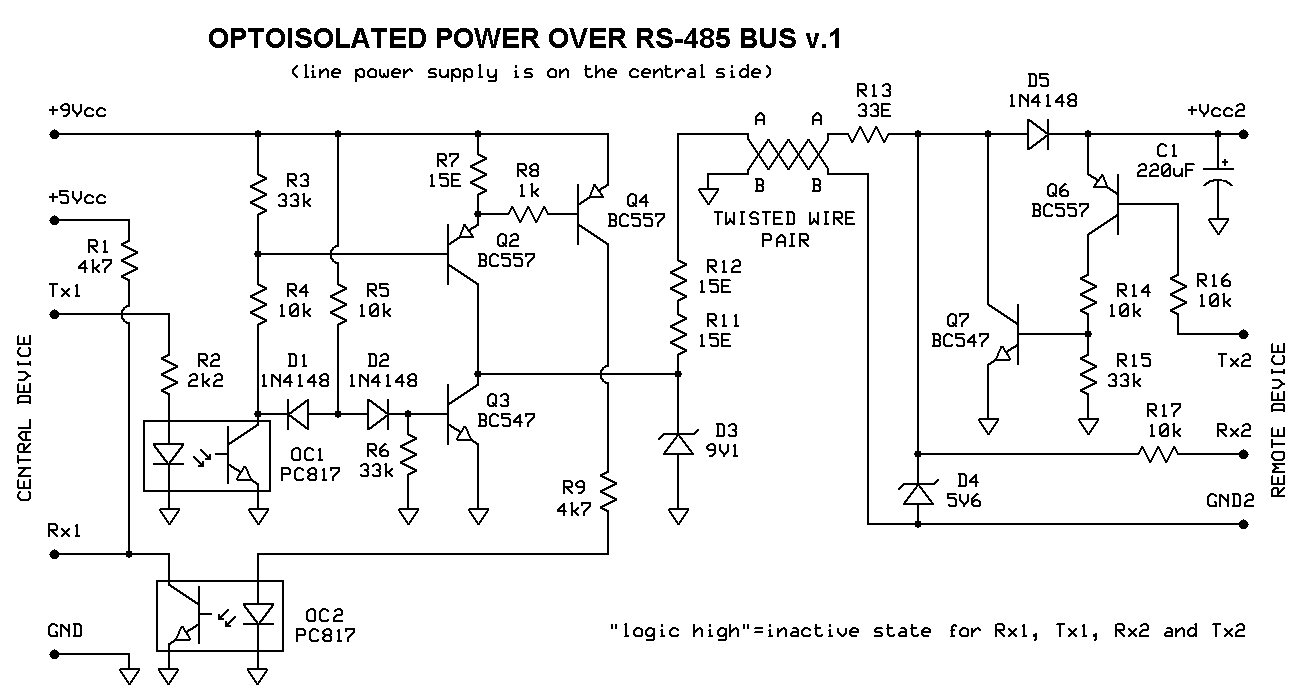The next circuit diagram presents the method of providing optical isolation to central device Rx1 and Tx1 pins while at the same time electrically powering the remote device from the central location. The driver circuit is simmilar to the first variant described on the previous page, the only difference being a pair of optocouplers inserted into Rx1 and Tx1 data lines.

Since electrical power for supplying the remote party is drawn from the same supply unit used for powering the central device, one might ask why optical isolation at all? Its purpose is to isolate the expensive central device, a powerfull microcontroller, PC or simmilar sophisticated unit from overvoltages that might occur in the data line in operation. Insulation in standard optocouplers such as PC817 series withstands up to 5kV of voltage difference between its input and output pins so one can be sure that the precious one will not be destroyed overnight. Power supplies are generally much sturdier than digital logic meaning that they do not need the same level of protection. In case a system designer is still afraid that something nasty might scrape through voltage stabilisers, power supplies for the central device and the central driver can be built as a fully separate units.
What is worth remembering is that electrical isolation is put close to the
central party. There are two good reasons for this:
-
Remote devices do not need any kind of insulation if data line has no electrical contact with the earth ground i.e. if it is left "floating" with respect to it, as it should be the case. This way "common mode" overvoltages induced into the data line, which can reach significant values in volts, have no closed path to the ground so no damage can be caused to the remote party. Much smaller "differential mode" surges are easily trapped by the protective Zener diode.
-
In systems in which there is more than one remote device present, a "central" device is probably placed somewhere near the geometrical center of the area. This puts it in particularly unpleasant position in terms of combating overvoltages as it acts as a crossroads to every surge wave that wants to travel up and down the lines. If we cut electrical paths at the central location by inserting optocouplers, much of the misfortunes are prevented.
Another improvement in comparison to the basic circuit is the higher voltage provided by the central driver to the data/supply line. The aim is to enable much longer cables to be used. We haven't tested the maximal range yet but calculations suggest that communicating with low power sensors drawing less than 10 mA should be possible over distances up to a kilometer or so. In addition, if line length is not in focus, remote devices can take more than 15 mA, say up to 30 mA for their needs. For example, this enables using several LEDs or 7-segment LED displays inside the remote device for more advanced human interraction.
Of course, some people and some circuits simply never have it enough. If more than a few tenths of miliamps is needed by the remote device to operate, then it will be very wise to consider stretching another pair of wires in parallel to the data line, dedicated solely to power supplying purposes. That can be avoided by increasing the data line voltage to some degree, but it would call for making significant upgrades to central drived components in terms of both voltage tollerances and power handling abbilities. To cut the long story short, it's simply not worth the trouble. But if for whatever reason drawing a few additional lines is not an option, one might opt for the solution given on the next page.

